For modern acid batteries, the primary medium in which the reactions take place is the electrolyte. From its quantity, temperature, electrochemical characteristics fully depends on the work of the entire battery. For each season, the composition of the electrolyte for batteries must have a certain density. This will ensure the duration and correctness of its operation.
In serviced batteries, you can control the composition and density of this fluid. This operation is performed using a specific set of tools.
Content
- 1 Characteristics of the composition
- 2 Work on checking the electrolyte in the battery
- 3 Electrolyte parameters in different temperature conditions
- 4 Electrolyte preparation
- 5 Electrolyte refill
- 6 Possible difficulties in the work
- 7 Conclusion
Characteristics of the composition
Основные компоненты, из которых состоит электролит, знакомы даже школьнику. Поэтому ответом на вопрос, what acid in car battery, является «концентрированная серная кислота». Для обеспечения работы автомобильной АКБ ее разбавляют дистиллированной водой.
The maximum acid density is 1.84 g / ml. However, motorists are more likely to use diluted fluid, which has an indicator of 1.4 g / cm.3. In the process of dilution of sulfuric acid produces a lot of heat.
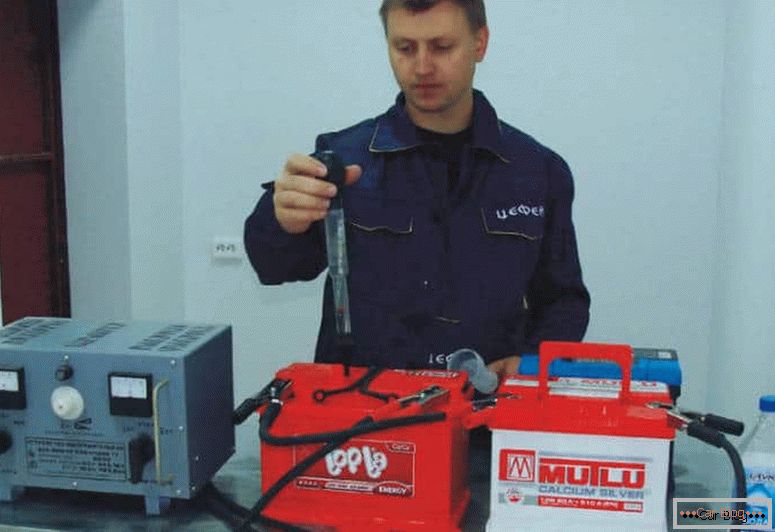
Work with electrolyte
You need to know that acidic solutions are used for batteries that have a very high degree of purification from unwanted impurities.
The parameters that the acid must meet are even described in state standards. GOST 667-73. This is due to the fact that trash impurities significantly reduce the service life of the appliance.
The main criterion for distinguishing between solutions is the density of the liquid. It is necessary that this parameter does not exceed 1.07 ... 1.3 g / ml. These results provide an approximate content of concentrate H2SO4 at the level of 27-40% in solution.

You need to know that in reference books the acid readings in the solution are most often indicated at 15C. If the ambient temperature changes, it is necessary to include a correction temperature coefficient in the calculation.
Work on checking the electrolyte in the battery
This operation should be carried out at least twice a year: with the onset of cold weather and with the establishment of summer warm weather. It is the temperature change that should be decisive at the beginning of the test.
Work is carried out in the presence of such an auxiliary set:
- a hydrometer is a device with which the density of liquids is checked (it is easy to find it in almost any auto shop);
- a glass tube with an internal diameter of 5-7 mm (in some cases it will be replaced by a blank sheet of paper).
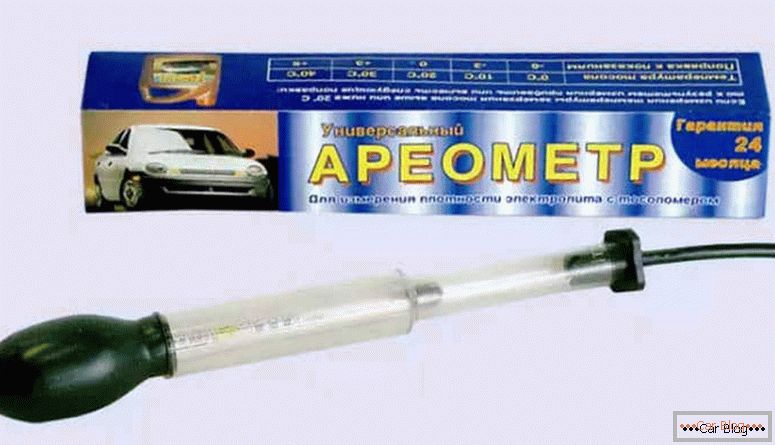
Car hydrometer
Preparation of electrolyte for batteries begins with checking the current state of the liquid in all banks. To do this, you can use a simple algorithm:
- in serviced batteries, unscrew the plug from the test jar;
- shallowly dip the working part of the areometer into the container with electrolyte;
- using a rubber bulb on a hydrometer, we pull in a small volume of liquid so that the float goes into a raised state and floats without touching the walls of the vessel;
- on the contact line of the electrolyte and the rod there will be real density data;
- write the result on a sheet of paper.
The measurement procedure is carried out for each container separately.
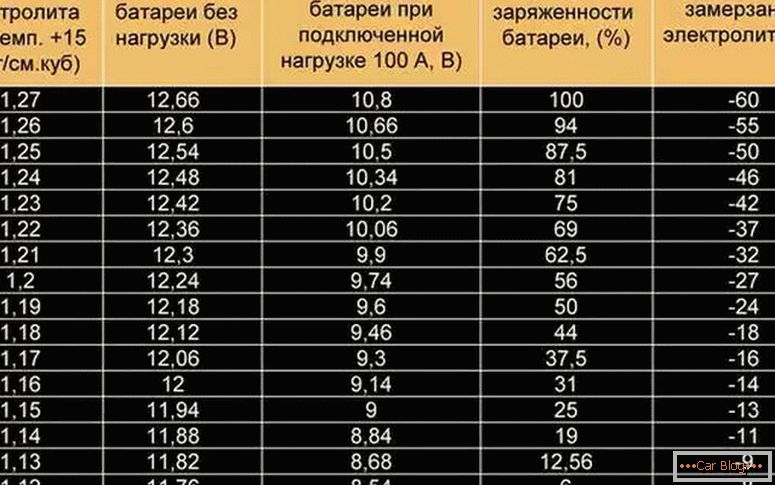
You need to know that the density values in all banks should be as close as possible to each other and should differ from each other by more than 0.2-0.3 g / cm3.
The lack of density can be compensated by a higher charge level. This will provide a greater indicator of density, and consequently a lower freezing point of the liquid.
In addition to the density of the driver during the operation of the vehicle must maintain a sufficient level of fluid in the battery. It is not recommended to lower it lower than 10-15 mm above the top level of the plates.
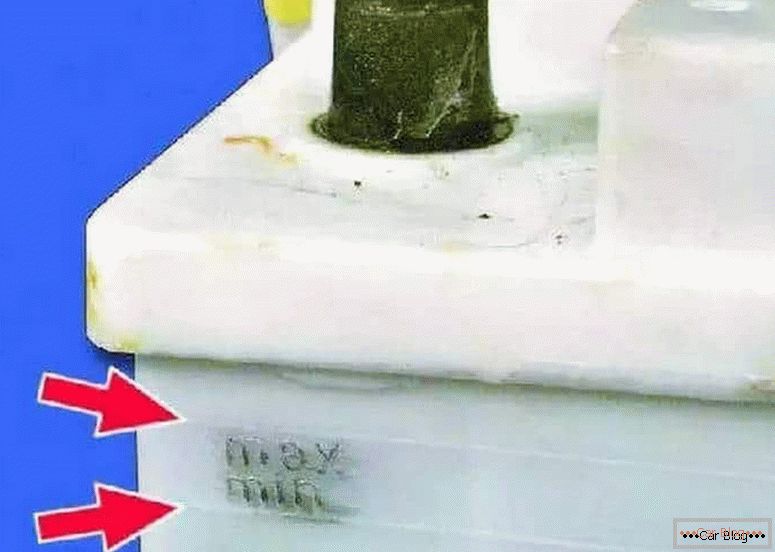
Liquid level in battery
Level measurements can be easily made using a glass tube on an evenly mounted horizontal battery. To do this, drop it into the selected jar so that its lower end touches the top of the plates. After that, close the tightly open end of the tube with your finger, in order to avoid leakage of fluid from the cavity of the tube. Measure the resulting level with any line.
See also: How to pick up the battery by brand of carIf an insufficient amount of liquid is detected, it is necessary to replenish the distillate in the problematic jar in several passes. During the procedure, there will be a little heat or boiling.
You need to know that in no case should you be topping up the electrolyte in the battery to bring the liquid to the required level. This action can ruin the battery.
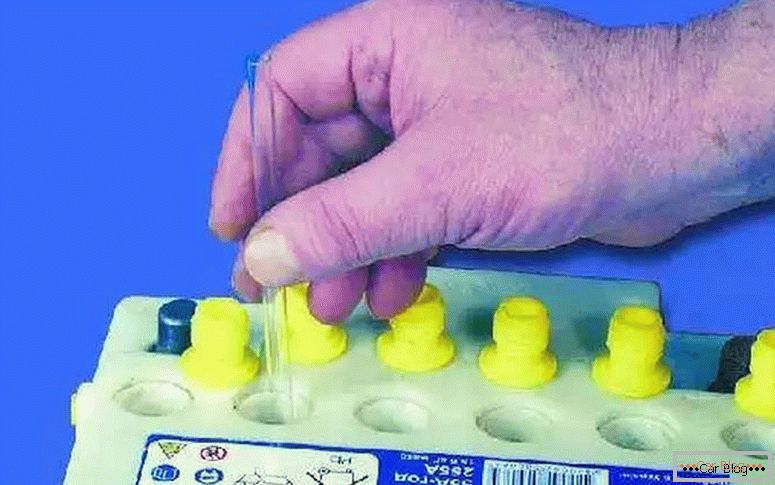
Electrolyte test with glass tube
The level check in the absence of a glass tube may be carried out using a clean sheet of paper rolled up into a small tube. The procedure will be the same, but it should be noted that in this case, wetting will show a slightly higher level of electrolyte due to measurement error.
Electrolyte parameters in different temperature conditions
For each season or climatic zones, the corresponding electrolyte parameters in density are maintained.
You need to know that for winter conditions and colder climatic zones, the electrolyte density should be higher, since this will provide a significant decrease in the freezing temperature of this fluid.
In hot climates and during warm ambient temperatures, it is desirable to maintain a lower electrolyte density., as it provides much longer battery life.

The correct parameters can be maintained thanks to a special table that determines the favorable density for the season and climatic conditions. In harsh conditions and with an extreme decrease in temperature, it is recommended to bring the battery into a warm room. In the same place it is possible to carry out its charging and checking of electrochemical parameters.
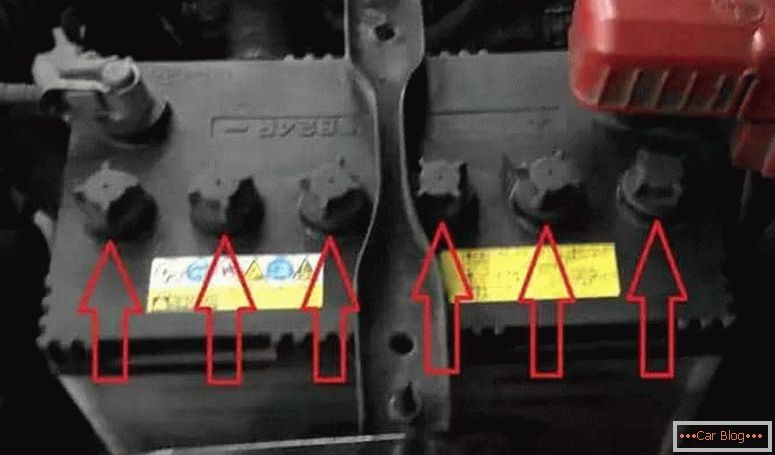
Plugs in serviced battery
With a low density of 1.1 g / ml, the liquid is capable of the appearance of ice crystals even at -6S. Therefore, even for driving in the cold, motorists in the northern regions use special thermal containers that protect batteries.
Electrolyte preparation
In auto shops, new batteries are offered for sale already filled with the necessary amount of prepared liquid. However, there are instances that require refueling, dry-charged battery. This option will be more appropriate for extreme climatic zones that require an individual approach in the preparation of electrolyte. For novice motorists, the most profitable option would be to buy an already prepared liquid for specific climatic zones.
If you can not find the finished volume, you can create a solution for your own conditions. Required attributes:
- capacity with distilled water, which can be found either in the pharmacy or in the auto shop;
- acid H2SO4 (sulfuric) with a density level of 1.4 g / cm3 (preferred rate) or 1.84 g / cm3 (used as a last resort);
- tared capacity, with which you can measure the required volume of fluid for work;
- a tube or rod of chemically neutral materials (ebonite, glass, ceramics) for mixing the solution;
- individual elements of protection (glasses, high-quality rubber gloves, protective apron, jacket with long sleeves).
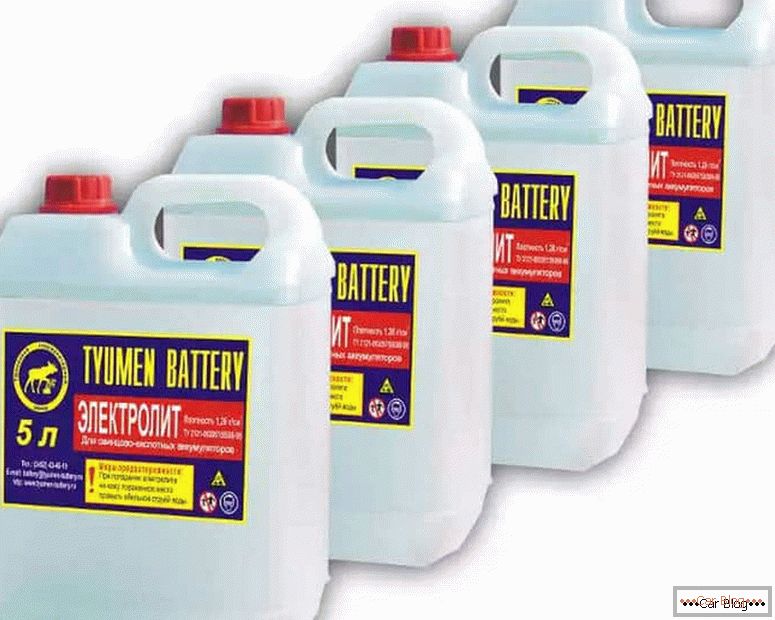
When working with chemical reagents, you will need to follow some rules:
- it is forbidden to pour water into acid, especially with a sharp movement, as this causes splashing and chemical burns;
- allowed topping up the acid in the water with a thin stream;
- during topping up, mix by means of a straw or ebony stick.
After making the necessary doses, a mandatory density measurement is performed using a hydrometer.
During the preparation of the electrolyte, you need to know the required amount of liquid in the battery. The volume in different models varies in the range of 2.6 ... 3.7 l. For replacement, you can prepare a liquid with a margin, and dispose of the residue with baking soda.
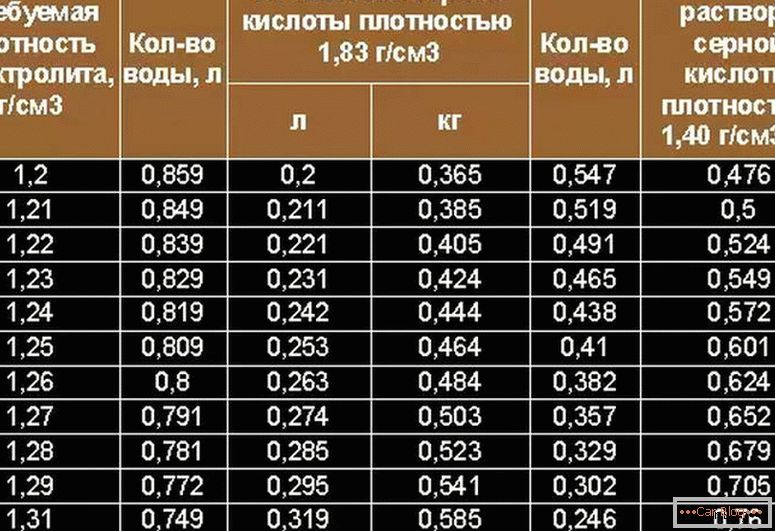
There are certain proportions for preparing a solution of a given density. The input is a proportional amount of acid and distillate.
Electrolyte refill
Fill the prepared liquid must be very carefully. This is done using a glass funnel or from another chemically neutral material. A glass mug with a special bent spout is also suitable.
The operation is carried out until the liquid rises above the plates in banks by 10-15 mm. Next, leave the entire system for 2-3 hours alone. After this time, the density of the medium may drop slightly, which is a valid phenomenon.
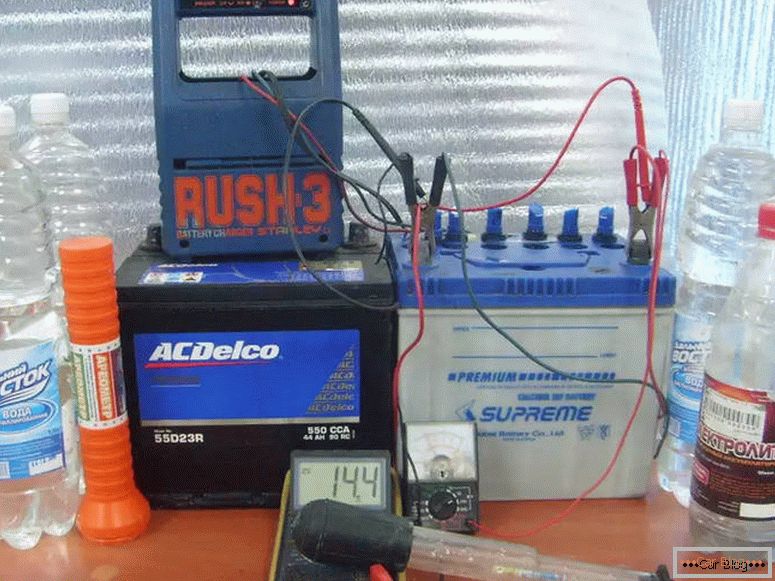
Battery charging
Charged battery must be charged to the operating mode. For this operation, a current is used that is 10 times less than the value indicated as the capacity on the battery case. This means that for a reading of 60 A * h outside the battery, a current of 6 A is required. Charging should be continued for 4 hours. After that, the density and level of the liquid is measured again. Electrical appliance prepared for use.
Possible difficulties in the work
A car battery during operation can get into various situations, for example, in its case the electrolyte will begin to freeze and crystallize. No burners can be used in this case. It is enough to disconnect it from the electrical wiring and bring it into a warm room for 12-20 hours. This procedure will ensure uniform thawing of all cold tanks.
If the driver noticed cracks caused by freezing or for other reasons, then such a battery is not subject to further use. It must be disconnected from the terminals and immediately get out of the engine compartment.
When the housing swells up without damaging it, you can charge it by adjusting the charger to supply a current of 1 A for about 1 day.
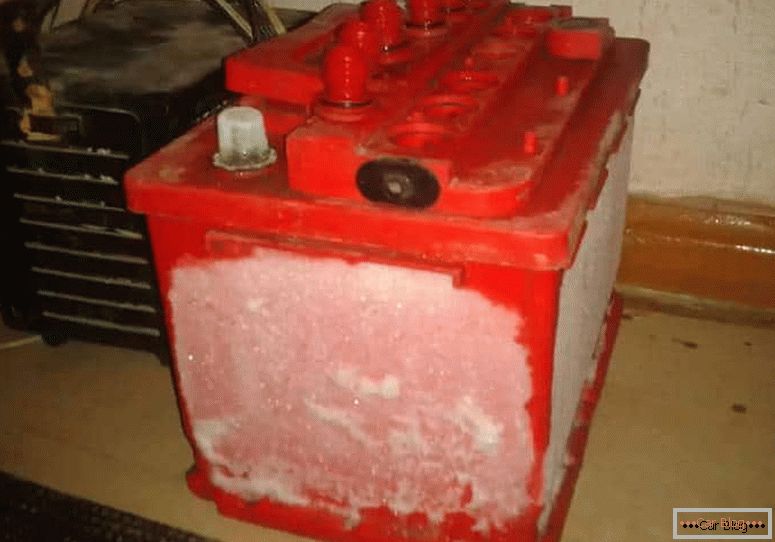
Frozen battery
This will require several times to monitor the density of the electrolyte. With a noticeable increase in density during charging, you need to know that the battery can last for some time.
Separate copies of the battery with a significant discharge do not gain the required capacity during charging. Complete replacement of electrolyte in all tanks is allowed. Pre-banks washed with distilled water before pouring the prepared solution. Then the battery is left for a couple of hours to impregnate the plates, and after that they are put on for two days to charge with current from half ampere to 1 ampere. The procedure is completed after the density does not change for 2 hours.
Conclusion
The quantity and quality of electrolyte affects battery performance. Density readings in serviced batteries are monitored at least twice a year. If the liquid level in the cans drops, then it is necessary to add distilled water. When purchasing dry charging batteries, it is also advisable to purchase a prepared solution from reputable manufacturers using highly purified acid. During self-preparation of the solution, you must comply with all measures of individual safety.



